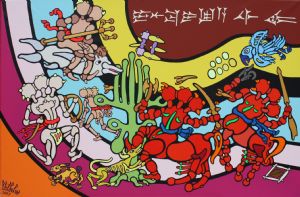| |

|

|
B109 - WHEN THE GODS WERE (still) MEN .2009
Painting Acrylic
Size: 125 x 190 cm - 49,2 x 74,8 inches
15330 USD
Description:
BABYLONIAN / Acrylic on canvas 125 x 190 cm - 49,2 x 74,8 inches.
Like many other paintings in the series Babylon, the title of this painting is an incipit or first words of the poem of Atra-Hasis. The poem begins: 'inum ilu awilum ... "Or:" When the gods were men ... "That means they have behaved like them, while men did not exist! Other translations are: "When the gods were man ..." = They behaved like them, or "When the gods were holding the man ..." = They held the man's role. As you can see, there are several possible titles as translators, so I approve all, especially since at first glance, the meaning does not leap to the eyes. Turning to the interpretation of the painting depicts the behavior of gods before the creation of man on earth. The show is familiar to us as they wage war with each other! We found many glyptic evoking the war of the gods. Anthropomorphism seems to be the rule most commonly accepted. The images of gods are not gods themselves, they are only representations as well as emblems. Do not be astonished at their appearance whatsoever in the earliest writings about the gods, the interpenetration of divine and human is always closely linked. The Mesopotamians had their own interpretation of the relationship between homological deity's body, its symbol and its anthropomorphic representation, it is difficult to understand in today's world: But easy to imagine for a Battle of the Gods ! Do not worry, they had the power to revive or otherwise, if they were in pieces, to recover the pieces to create other characters, which sometimes become demi-gods, others mixed with clay and the blood of a sacrificed God become mortal humans first born! That is what tells us in miniature the oldest known mythology, but also unquestionably and by far the longest "religion" has existed on earth!
To return to the heart of the table, here is some more information:
The colored belts worn at the hips of the gods are the beginnings of future floating ribbons or "pativ" borrow later Parthian horsemen and fighters Sassanid. The tree of life is already present in the landscape zenith. Above a shooting star! Then the seven stars of Pleiades near our bird. Below a centaur brandished in his right hand the monogram of Philhelm! In the lower right corner on the most sacred symbol in recurrent glyptics Mesopotamian sometimes interpreted as the eye of a god! The seated figure with trident on a dolphin is the ancestor of Poseidon in Greek. When the overlapping curves background colors, they correspond to different layers of the world exists under the belief of the time.
Atra-Hasis (or Atrahasis) Super good poem (or infinitely wise) is a Semitic language written in Akkadian cuneiform and therefore approximate date of the eighteenth century BC, tells the story of the Creation and the flood. The poem has about 1200 verses, the Bible was inspired to create the character of Noah.
Addendum: If the characters are so curious, if not extraordinarily anthropomorphic, that they are borrowed from Etruscan few rare stamps, which I kept long in my possession in order to reveal them one day in one form or another . The Etruscans were of Anatolian origin, the creative leap did the rest. I would also like to emphasize that the round heads of the characters were already painted ocher yellow-brown rocks at the Jabbaren n'Ajjer Tassili in Algeria, and this, as attested to 7000 years old de5000! When the double or triple heads, they are already certified as a minimum since 7500 BC, and at Catal Hayak in Central Anatolia.
|
|

|
|